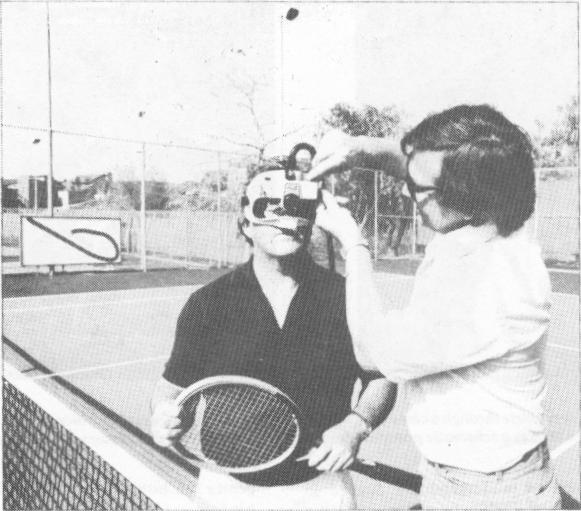| Previous | Index |
![]()
At the new Coto de Caza Sports Research Center in California. Ariel rigs tennis coach Vic Braden with a mask that monitors movements of the eyes as they try to stay focused on the ball.
He has even designed one that is inflatable; put it on, pump in the air, and the shoe conforms to the contours of an individual foot. He also owns numerous patents, 15 alone on an exercise machine to be distributed by Wilson Sporting Goods. Instead of weights, Ariel's system uses hydraulics to build up the muscles, and a computer to monitor and give instant feedback on performance. "In less time," he explains, "an athlete, and especially weekend players, can increase physical capacity without overextending the muscles."
CBA is making some non-sport studies as well. Kimberly-Clark, the paper company, has asked for help in building a better carton for packing heavy refrigerators for delivery. An insurance company seeking a more honest count on disability claims has come to Ariel because he says that he can tell when a person is lying about a low-back injury.
Obviously, business has never been better. But no man to stand still for very long, Ariel is now involved in a venture that would seem to be the pot of gold at the end of his rainbow. As part of a new resort and convention complex in southern California, he will have his most complete research facility for
studying athletic movement. The twostory Coto de Caza Sports Research Center will be fitted out with the best equipment money can buy. Along with all the computers and cameras that a biomechanic could want, there will be a 200-meter running track inlaid with $25,000 worth of sensor plates to measure a runner's foot-fall pressure and the deterrent forces that cause injuries. There also will be the use of an extensive track-and-field setup-including discus and shot-put rings, pole-vault and high-jump pits-a golf course, and the more than 40 tennis courts of the Vic Braden Tennis College, next door and also part of the resort.
In fact, it was Vic Braden who opened this door for Ariel. A trained psychologist as well as one of the country's leading tennis instructors, Braden opened his college at Coto de Caza in 1974, in the early stages of the Penn Central-financed development. About that same time, Bill Toomey, 1968 Olympic decathalon champion and a friend of both Braden and Ariel, suggested that they get together. It was a connection Toomey sensed would be fruitful.
"Gideon and I hit it off immediately," Braden recalls. "1 have some training in
math and physics, we are both deeply interested in athletics and finding new ways to play better, and we both like to talk. The first time we met it was a tenhour talkathon. It's been like that ever since.
"How has my teaching been influenced? One example. As Gideon has proven, the tennis ball doesn't stay on the racket very long, so it is not only pointless but you can also tear up your elbow if you roll the racket over at impact to achieve top-spin. It's the angle of the racket before and at impact that gets the job done. I had pretty much deduced that over the years, but Gideon authenticated it. His computer doesn't miss a thing."
Soon after they met, Ariel confided in Braden his dream of someday having a complete athletic research center. So Braden introduced Ariel to the Penn Central people, and Ariel, who is a forceful, effusive speaker even in his thick Hebrew-accented English, took it from there. The center is scheduled to open this month, with Ariel in charge and a joint partner in the profits.
As might be expected, he talks of Coto in expansive terms: "We will have an Institute for Cybernetic Research to do pure research on human movement, control, and locomotion. There will be an Institute for Talent Recognition; parents can send their kids to us for testing to find which sport they are best suited for. The parents can find out things about themselves, too, and we'll have an executive fitness program.
"Some professional football teamsI can't say which ones-are going to come to be tested and analyzed. What's the most efficient way to block, tackle, snap the ball? We'll find out. Japan has talked about sending its volleyball team to Coto. Argentina's World Cup champion soccer team is coming. Spain wants to send its entire Olympic team. We'll have everything here for everybody. The computers, the testing grounds, the weather, everything."
About 400 miles inland and approximately halfway between San Diego and Los Angeles, Coto de Caza is in a lush valley surrounded by mountains. It has a reputation as being among the finest equestrian and hunting grounds in the west; loosely translated, Coto de Caza means the "Hunting Preserve." With Gideon Ariel in place, that takes on a double meaning. The hunt is one, in earnest, for human athletic excellence. ∎
A( Barkovv is a free-lance writerspecializing in sports.
USAIR MAGAZINE October 1980

![]()
| Previous | Index |